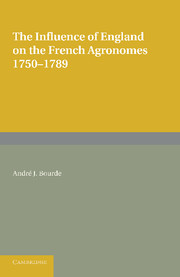Book contents
- Frontmatter
- Contents
- LIST OF ABBREVIATIONS
- Preface
- PART ONE THE PREPARATORY PERIOD 1700–50
- PART TWO DUHAMEL DU MONCEAU'S WORK
- PART THREE AGRARIAN REPERCUSSIONS OF THE NOUVEAU SYSTÉME
- Chapter VI Elaboration of the Doctrine of Rotative Cultivation and its Theoretical Consequences
- Chapter VII Social, Juridical and Political Implications of the Nouveau Systéme
- PART FOUR HOW THE NEW HUSBANDRY WAS INTENDED TO ENRICH FRENCH AGRICULTURE
- PART FIVE SOME ASPECTS OF THE INTERNAL LIFE OF THE AGRONOMIC MOVEMENT
- Conclusion
- Appendix I
- Appendix II
- Bibliography
- Index
Chapter VI - Elaboration of the Doctrine of Rotative Cultivation and its Theoretical Consequences
from PART THREE - AGRARIAN REPERCUSSIONS OF THE NOUVEAU SYSTÉME
Published online by Cambridge University Press: 05 June 2016
- Frontmatter
- Contents
- LIST OF ABBREVIATIONS
- Preface
- PART ONE THE PREPARATORY PERIOD 1700–50
- PART TWO DUHAMEL DU MONCEAU'S WORK
- PART THREE AGRARIAN REPERCUSSIONS OF THE NOUVEAU SYSTÉME
- Chapter VI Elaboration of the Doctrine of Rotative Cultivation and its Theoretical Consequences
- Chapter VII Social, Juridical and Political Implications of the Nouveau Systéme
- PART FOUR HOW THE NEW HUSBANDRY WAS INTENDED TO ENRICH FRENCH AGRICULTURE
- PART FIVE SOME ASPECTS OF THE INTERNAL LIFE OF THE AGRONOMIC MOVEMENT
- Conclusion
- Appendix I
- Appendix II
- Bibliography
- Index
Summary
The mechanical aspect of the ‘English Method’ (i.e. actual manipulation of the land) was less important perhaps than the fact that it brought with it new ideas about crops already known and implied, with the introduction of new ones, a profound change in the agricultural landscape of the country.
It would certainly be going too far to say that English influence only was responsible for this movement. Indeed, other influences could also be felt. All the same, though English influence was not exclusive, it was undoubtedly by far the most important. And up to a certain point, as it is originally the source of the whole economic movement in the second half of the century, so, one can trace it all through the movement of agrarian reforms that occurred in connection with the new economic trends of the time. That is why it may be not without interest to endeavour to discern among these the part played by English-inspired tendencies.
The new system opened two ways to agriculture. Once the solution of breaking the land either with ploughing or with manures was agreed, the wider consequence of Duhamel's theory very soon appeared. The mechanical principle of it theoretically involved the constant occupation of the land by cultivated crops (in the case of Duhamel, it was wheat), which itself in suppressing the fallow made necessary the existence of extensive pastures of artificial grasses. Whatever the intrinsic value of Tull's theory, the fact is that its translation raised this problem, for the first time, for the consideration of French agronomers. The relations which were soon found to exist between occupation of the soil by corn on the one hand, and the new crops on the other (for instance, alternation of wheat and turnips or sainfoin) had been, it is true, suspected before Duhamel. Liger had noticed that certain plants could be of value in improving the yield of the succeeding crops. The idea of an uninterrupted cultivation was not altogether unknown. But such an agriculture had neither a definite method nor a clearly realized purpose. Often the peasant tried to get as much as possible out of his land, especially when he was established on a short-term lease, and therefore did not care much about the consequences of his method of cultivation. In other parts of the country, agricultural experiments were governed by an almost blind empiricism.
- Type
- Chapter
- Information
- Publisher: Cambridge University PressPrint publication year: 2013



